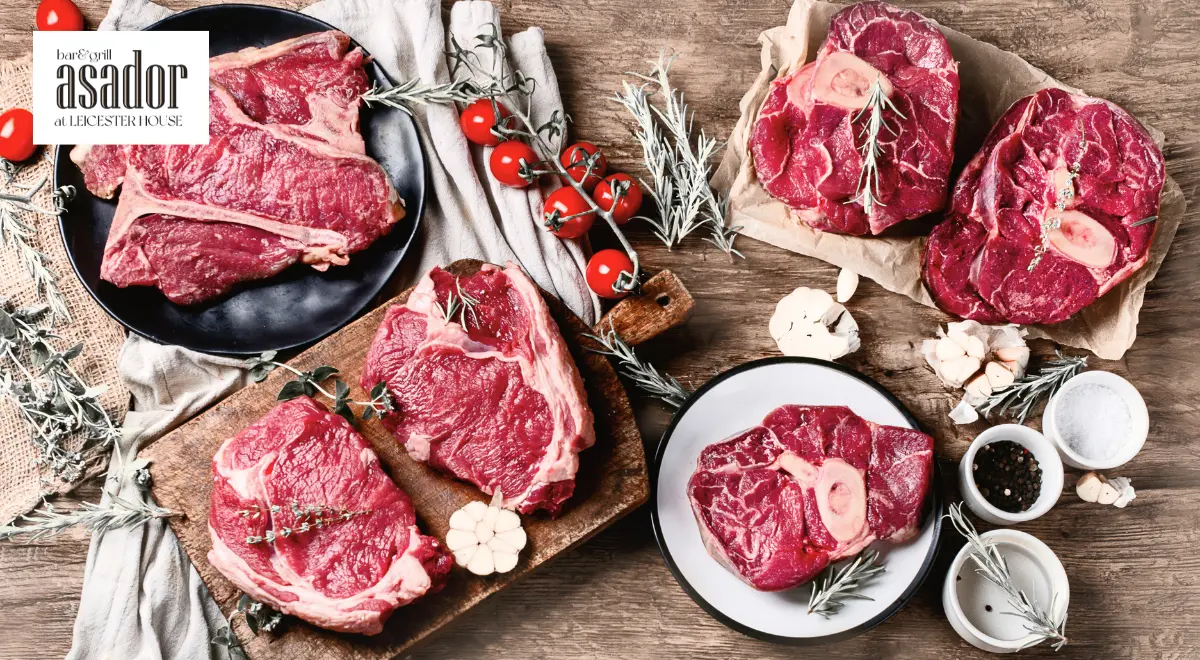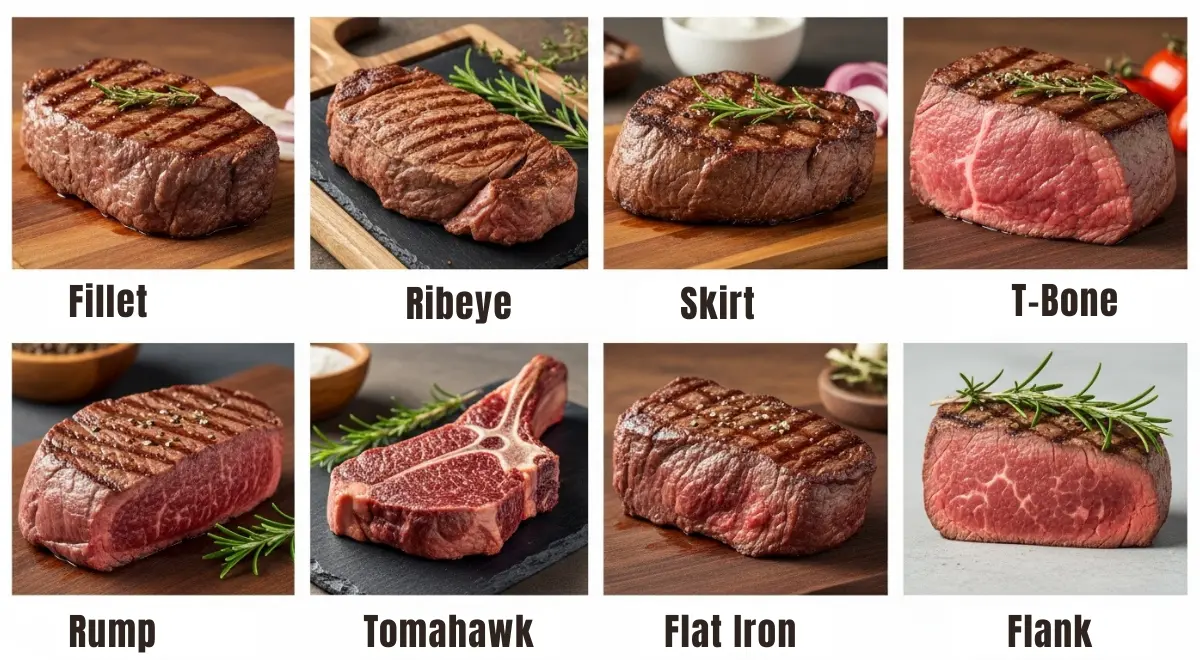Different Types of Steak Cuts: Flavours, Textures, and Cooking Guides
- Ağustos 20, 2025
- asagiris
- 12:55 pm
Steak is simple, satisfying, and full of flavour, but not all steaks are the same. There are many types of steak cuts, each coming from a unique part of the animal, and each with its own texture, fat content, and best cooking method. Understanding the types of steak can help you choose the perfect cut, whether you’re planning a romantic dinner, a weekend barbecue, or just a quick pan-fry after work.
Some types of beef steak are prized for tenderness, others for rich, beefy flavour. Some need just a quick sear, while others shine with slow cooking. This guide covers the most popular steak cuts, where they come from, their texture and flavour, and the best ways to cook each one.
The Most Popular Types of Steak Cuts and How to Cook Them
Here’s a guide to the most popular beef steak cuts, where they come from, and how to cook each one to perfection. You can also view these cuts and more on our menu.

Fillet (tenderloin)
- Where it comes from: The loin, tucked inside the rib cage.
- What it is: The most tender cut, very fine texture and mild flavour.
- Best cooking: Quick sear in a hot pan, or grill briefly. Also great for dishes like steak Diane or beef Wellington.
- Doneness: Rare to medium rare keeps the texture delicate.
- Serve with: A light sauce or a knob of butter. Fine salt and pepper are usually enough.
Ribeye (rib)
- Where it comes from: The rib section.
- What it is: Generous marbling and fat, very juicy and flavourful.
- Best cooking: High heat grilling or pan sear for a caramelised crust. Bone-in ribeye intensifies the flavour.
- Doneness: Medium rare to medium to let the fat render but keep the meat succulent.
- Serve with: Chimichurri, roasted garlic butter or simply salt.
Now that you know the cooking times, explore our full guide on how to cook ribeye steak step by step.
Striploin / New York strip (sirloin short loin)
- Where it comes from: The short loin.
- What it is: Tender with a firm chew and a pronounced beefy flavour. Less fatty than ribeye.
- Best cooking: Grill or pan sear, finish in the oven if thick.
- Doneness: Medium rare to medium for balance.
- Serve with: Peppercorn sauce or a simple herb butter.
Porterhouse and T-bone
- Where they come from: The short loin. Both contain a section of fillet and striploin separated by the bone.
- What they are: Porterhouse contains a larger fillet than a T-bone. Both give two textures in one steak.
- Best cooking: Grill over moderate to high heat to cook both sides evenly. For thick steaks, use reverse sear or finish in oven.
- Doneness: Aim for medium rare in the fillet section; remove early if the fillet cooks faster.
- Serve with: Sliced and shared, ideal for two people.
Sirloin (top sirloin)
- Where it comes from: The back near the rear of the animal, above the rump.
- What it is: Good beefy flavour, firmer than fillet but still tender when cooked correctly.
- Best cooking: Grill or pan sear. Excellent sliced thin for steak salads or sandwiches. For detailed tips on cooking sirloin to perfection, check out our sirloin steak cooking guide.
- Doneness: Medium rare to medium.
Rump
- Where it comes from: The hindquarter.
- What it is: Lean, robust flavour and firmer texture. Better value than more tender cuts.
- Best cooking: Best when cooked medium rare and sliced thin across the grain. Also great for barbecues and stir fries.
- Doneness: Medium rare to medium.
Flat iron (from shoulder blade)
- Where it comes from: The shoulder blade.
- What it is: Very tender for a shoulder cut and great value. Good marbling and steady texture.
- Best cooking: Quick grill or pan sear. Marinate or season well. For detailed tips, see our how to make flat iron steak guide.
- Doneness: Medium rare to medium.
Hanger steak (often called onglet)
- Where it comes from: The diaphragm region, near the flank.
- What it is: Rich flavour, slightly coarse grain, very beefy. Traditionally prized by butchers.
- Best cooking: High heat and serve rare to medium rare. Slice thin across the grain.
- Doneness: Rare to medium rare for best tenderness.
Bavette and flank (flank and bavette / flap)
- Where they come from: Flank and lower belly area.
- What they are: Long grain, pronounced beefy flavour, lean. Bavette and flank are similar but differ by texture.
- Best cooking: Quick sear or grill at high heat, or marinate first. Slice very thin against the grain.
- Doneness: Medium rare to medium. Overcooking makes them tough.
Skirt steak
- Where it comes from: The plate beneath the rib section.
- What it is: Very flavourful and fibrous, best sliced thin across the grain.
- Best cooking: Very high heat for a short time, then slice thin. Classic for fajitas. For step-by-step instructions, see our how to make skirt steak guide.
- Doneness: Medium rare.
Picanha (rump cap / croupe)
- Where it comes from: The rump cap, popular in Brazil and Argentina.
- What it is: A cap of meat with a thick fat layer. Juicy and full of flavour when the fat renders.
- Best cooking: Grill or spit roast, cook fat side first to render.
- Doneness: Medium rare to medium, depending on preference.
Short ribs / Asado
- Where they come from: The Rib and plate area.
- What they are: Rich, gelatinous when slow-cooked, very beefy. In Argentinian-style asado, short ribs are a barbecue staple.
- Best cooking: Slow roast or low and slow barbecue. Also excellent when braised.
- Doneness: Cook long enough until tender.
Tomahawk steak
- Where it comes from: Ribeye with an extra-long bone left attached.
- What it is: Eye-catching presentation, same meat as ribeye, but dramatic.
- Best cooking: Reverse sear works well: cook gently, then finish with a high sear.
- Doneness: Medium rare to medium.
Choosing the Right Steak for You
- For tenderness: Fillet is unmatched.
- For flavour: Ribeye or skirt steak offers the richest taste.
- For sharing: Go for a large porterhouse, T-bone, or tomahawk.
- For value: Rump, flat iron, or flank steak gives big flavour at a lower price.

If you’re looking to enjoy these cuts at their very best, a visit to the best steakhouse in Leicester Square is highly recommended. Asador Bar & Grill serves perfectly cooked steaks in a welcoming atmosphere, whether you prefer a tender fillet, a juicy ribeye, or a flavourful skirt steak.
Conclusion
Choosing the right steak cut comes down to your taste, texture preference, and cooking style. Some cuts, like fillet, are naturally tender and lean, while others, like ribeye or T-bone, are rich with marbling for a juicier bite. Understanding each cut’s origin and ideal cooking method will help you make the most of your steak, whether you’re firing up the grill or searing in a pan.
Book your table today and savour the ultimate steak dining experience at Asador Bar & Grill.
FAQs
What is the most tender steak?
Fillet is the most tender cut because the muscle is not used for movement. It has a delicate texture.
Which steak has the most flavour?
Ribeye is often considered the most flavourful because of its high marbling. Cuts with fat and connective tissue tend to be more flavourful once cooked.
How thick should a steak be?
For best results, aim for at least 2 to 3 centimetres for steakhouse style. Thinner steaks cook quickly and suit fast searing.
Can all steaks be grilled?
Most steaks can be grilled. Very tough cuts are better slow-cooked or braised unless they are sliced thin and cooked quickly.
Recent Post's
How to Choose the Right Restaurant in Leicester Square
How to Choose the Right Restaurant in Leicester Square September 19, 2025…
Where to Eat Near Oxford Circus: Discover Asador Bar & Grill
Where to Eat Near Oxford Circus: Discover Asador Bar & Grill September…
Why Argentinian Restaurants Are Popular in Leicester Square
Why Argentinian Restaurants Are Popular in Leicester Square September 9, 2025 asagiris…



